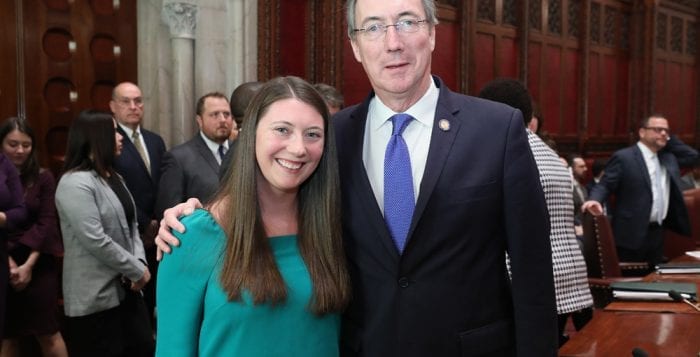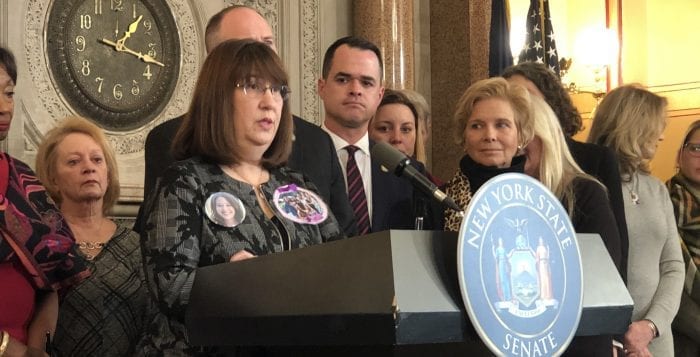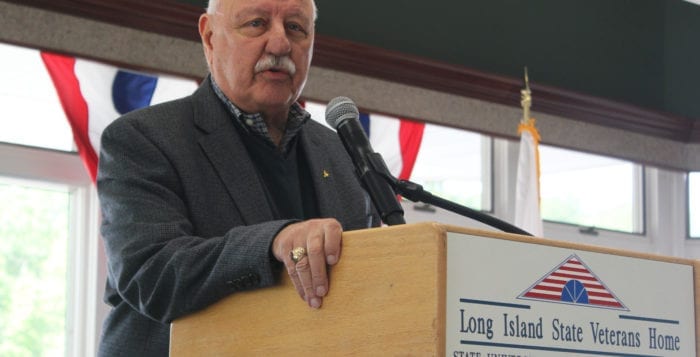Residents of both Brookhaven and Smithtown spoke during a Jan. 8 public hearing about the impact of the proposed development of the 75-acre Flowerfield/Gyrodyne site on Route 25A in St. James. While opinions varied, one thing was certain: The project will be the largest development the area has seen in quite some time.
The proposal seeks to subdivide the land into nine lots, keeping existing businesses and a catering hall while adding a 150-room hotel with a restaurant, two assisted living centers, two medical office parks and a 7-acre sewage treatment plant.
During the hearing, Gyrodyne representatives said they are taking a sustainable approach and have come up with multiple alternatives to the original plan that balance out potential impacts to the surrounding communities.
Kevin McAndrew, a partner at Cameron Engineering, a Woodbury-based firm hired by Gyrodyne, discussed the potential benefits of the project.
“The project would bring in significant economic benefits — generate over $3.5 million dollars, bring in high quality jobs and no increase to [area] school enrollment,” he said.
McAndrew said the firm has acknowledged traffic concerns in the area. The proposed plans, he said, such as the assisted living center, would contribute minimal traffic congestion during peak commute hours. The developer pointed out the inclusion of walking trails, bike lanes, green infrastructure and a potential sewage treatment plant at the site, which representatives said could be used for sewering for downtown St. James.
Despite what they heard from the presentation, many speakers and civic leaders said they were not convinced, including officials from Brookhaven, Suffolk County and New York State.
“This 75-arce project will undoubtedly be the largest development in the Smithtown/Brookhaven area for the next generation.”
– Ed Romaine
Ed Romaine (R), Brookhaven supervisor, said the project would impact the communities of Brookhaven in a devastating way.
“This 75-arce project will undoubtedly be the largest development in the Smithtown/Brookhaven area for the next generation,” Romaine said.
Romaine and others complained that Brookhaven is being left out of the planning process and their concerns are not being addressed. As the site is just outside their borders, it would impact their roads, particularly Stony Brook Road.
“I submitted extensive comments on the scope of the project, to this date I haven’t been contacted about any of these concerns,” the supervisor said. “25A is over carry capacity and we are going to add more? I have concerns about Setauket Harbor and water quality as well as this sewage treatment plant.”
Maria Hoffman, press secretary read a statement from Assemblyman Steve Englebright (D-Setauket):
“Shortcomings of this DEIS include the project’s impact on Stony Brook Harbor, will the onsite [treatment] plant become a regional sewer district? What type of sewer system will be purchased and installed, and will it remove nitrate? These meaningful unanswered questions need to be answered and resolved before the project is allowed [to move forward].”
Stony Brook resident Curt Croley said he’s worried about the project’s impact on property values.
“There is no doubt in my mind that this proposal is opportunistic based on available land,” he said. “I can’t help but wonder if there’s been enough diligence about the sewage treatment plant, the runoff and all the potential impacts that are so close to all these municipalities.”
Joy Cirigliano, chapter president of the Four Harbors Audubon Society, expressed concerns about the nearby harbor and other waterways.
“We already have water quality issues in Stony Brook Harbor and Smithtown Bay with Ecoli and hypoxia, adding more nitrogen to the harbor is significant,” she said. The applicant must analyze these impacts and the repercussions before proceeding with the plan.”
Artists, such as Kevin McEvoy, who had a thriving studio on the Flowerfield site, have already left. The atelier now has limited operations at Gyrodyne.
“The development of that property will only enhance us and allow us to grow,” she said. “[St. James] will become the microcosm of small-town life we yearn to be again.”
– Natalie Weinstein
Some Smithtown residents welcomed the project, because the St. James business district on Lake Avenue could tap into the project’s proposed sewage treatment plant.
Natalie Weinstein of Celebrate St. James stressed the importance of the potential project and how it would finally allow for the revitalization of Lake Avenue as a cultural art district.
“The development of that property will only enhance us and allow us to grow,” she said. “[St. James] will become the microcosm of small-town life we yearn to be again.”
Following the public hearing and end of the public comment input later this month, the Smithtown Planning Board will await submission of a final environmental impact statement in preparation for a vote on the Gyrodyne applications.
TBR News Media has previously reported that Smithtown has already received $3.9 million from Sen. John Flanagan (R-East Northport), so it can connect the Lake Avenue business district in St. James to the Gyrodyne sewage treatment plant.

















